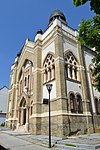

Lipót Baumhorn
| |
|---|---|
 | |
| Born | Baumhorn Lipót (1860-12-28)28 December 1860
Kisbér, Kingdom of Hungary
|
| Died | 8 July 1932(1932-07-08) (aged 71)
Kisbér, Kingdom of Hungary
|
| Nationality | Hungarian |
| Occupation | Architect |
| Practice | synagogues and other public buildings |
Lipót Baumhorn (Hungarian: Baumhorn Lipót, German: Leopold Baumhorn, 28 December 1860, Kisbér – 8 July 1932, Kisbér) was a Hungarian architect of Jewish heritage, the most influential Hungarian synagogue architect in the first half of the 20th century. He drew blueprints for about 20 synagogues in the Kingdom of Hungary.
He graduated from the main real school in Győr, the technical university in Vienna under Freiherr von Ferstel, König and Weyr. Then he came to Budapest and worked for 12 years in the office of architects Ödön Lechner and Gyula Pártos. In 1893 and 1899. He traveled to Italy, 1904. to Central Europe for architectural studies. His first independent work was the Moorish-style synagogue in Esztergom, built in 1888, which established his reputation. Since then, B. built 22 synagogues in Hungary, the most significant of which is Szeged (1903), which was one of the largest in the old Austro-Hungarian monarchy (with 740 men's and 600 women's seats), significant new rural, Nagybecskerek, Fiume, Brassó, Temesvár, Szolnok, Cegléd, Eger, Losonc, Liptószentmiklós, Budapest: Aréna-út, Páva utca, Csáky utca synagogues. Other buildings include: The King of Győr. table (1890), the glass factories of Salgótarján (1893), the pavilion of the paper and reproduction industry of the millennial exhibition (1896), the headquarters of the Temesvár Valley Water Regulatory Company, the Temesvár higher girls' school, the headquarters of the Szeged-Csongrád Savings Bank, (1903), the Újvidék Savings Bank the Baja Savings Bank, the Temesvár Lloyd and the Stock Exchange Palace (1910–12).[1]
Lipót Baumhorn designed many synagogues. The following is a detailed list:[2]
| No. | Location | Name | Built | Destroyed | Remarks | Picture |
|---|---|---|---|---|---|---|
| 1st | Esztergom, Hungary | Esztergom Synagogue | 1888 | stand | It is used for cultural purposes. | 
|
| 2nd | Rijeka, Croatia | Rijeka Synagogue | 1895 | 1944 | It was destroyed by Nazis. | 
|
| 3rd | Zrenjanin, Serbia | Zrenjanin Synagogue | 1896 | 1941 | It was demolished by the German occupiers during World War II, only its organ escaped. | 
|
| 4th | Timișoara, Romania | Fabric Synagogue | 1897–1899 | stand | It is in a dilapidated state, threatened with collapse. | 
|
| 5th | Szolnok, Hungary | Szolnok Synagogue | 1898 | stand | Recently renovated. The Szolnok Gallery operates in the building. | 
|
| 6th | Brașov, Romania | Brașov Synagogue | 1899–1901 | stand | Recently renovated. In use. | 
|
| 7th | Szeged, Hungary | Szeged New Synagogue | 1900–1902 | stand | It is the second largest synagogue in Hungary and the fourth largest in the world. Recently renovated. In use. | 
|
| 8th | Cegléd, Hungary | Cegléd Synagogue | 1902 | stand | It functions as a sports hall. | 
|
| 9th | Novi Sad, Serbia | Novi Sad Synagogue | 1905–1909 | stand | It is used for many cultural concerts and events. | 
|
| 10th | Satu Mare, Romania | Satmar Synagogue | 1906–1909[3] | after 1945 | It was demolished at an unknown time after World War II. | 
|
| 11th | Murska Sobota, Slovenia | Murska Sobota Synagogue | 1908 | 1954 | It was demolished in 1954. | 
|
| 12th | Budapest, Hungary | Arena Synagogue | 1908–1909 | stand | The building is now used by the Budapest Honved Fencing Hall | 
|
| 13th | Nitra, Slovakia | Nitra Synagogue | 1908–1911 | stand | Renovated from 2003, it is also available to the public as a museum of Jewish culture and a venue for various cultural events. | 
|
| 14th | Eger, Hungary | Eger Synagogue | 1911–1913 | 1967 | It was blown up, citing its exaggerated and degrading size of the settlement. | 
|
| 15th | Makó, Hungary | Makó Neological Synagogue | 1914 | 1965 | After the destruction of Makó Jewry in World War II, the synagogue lost its former role. In the 1950s and 1960s, several ideas were born for recycling, but they were eventually dismantled. | 
|
| 16th | Nyíregyháza, Hungary | Nyíregyháza New Synagogue | 1918–1923 | stand | In use. | 
|
| 17th | Budapest, Hungary | Páva Street Synagogue | 1923–1924 | stand | Recently renovated. In use. | 
|
| 18th | Lučenec, Slovakia | Lučenec Synagogue | 1924–1925 | stand | Recently renovated. It is used for cultural purposes. | 
|
| 19th | Gyöngyös, Hungary | Gyöngyös Synagogue | 1929–1930 | stand | Recently renovated. It is used for cultural purposes. | 
|
![]() Media related to Lipót Baumhorn at Wikimedia Commons
Media related to Lipót Baumhorn at Wikimedia Commons
You can help expand this article with text translated from the corresponding article in Hungarian. (December 2009) Click [show] for important translation instructions.
Content in this edit is translated from the existing Hungarian Wikipedia article at [[:hu:Baumhorn Lipót]]; see its history for attribution.{{Translated|hu|Baumhorn Lipót}} to the talk page. |
| International |
|
|---|---|
| National |
|
| Artists |
|
| People |
|